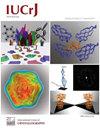Time-resolved serial synchrotron and serial femtosecond crystallography of heme proteins using photocaged nitric oxide
IF 3.6
2区 材料科学
Q2 CHEMISTRY, MULTIDISCIPLINARY
引用次数: 0
Abstract
We demonstrate the application of a nitric oxide releasing photocage system for time-resolved serial crystallography studies of two heme containing proteins using a fixed target sample delivery system. Optimal parameters for successful photocage activation and nitric oxide release are explored.
Time-resolved X-ray crystallography is undergoing a renaissance due to the development of serial crystallography at synchrotron and XFEL beamlines. Crucial to such experiments are efficient and effective methods for uniformly initiating time-dependent processes within microcrystals, such as ligand binding, enzymatic reactions or signalling. A widely applicable approach is the use of photocaged substrates, where the photocage is soaked into the crystal in advance and then activated using a laser pulse to provide uniform initiation of the reaction throughout the crystal. This work characterizes photocage release of nitric oxide and binding of this ligand to two heme protein systems, cytochrome c′-β and dye-decolourizing peroxidase B using a fixed target sample delivery system. Laser parameters for photoactivation are systematically explored, and time-resolved structures over timescales ranging from 100 µs to 1.4 s using synchrotron and XFEL beamlines are described. The effective use of this photocage for time-resolved crystallography is demonstrated and appropriate illumination conditions for such experiments are determined.
利用光笼型一氧化氮对血红素蛋白进行时间分辨连续同步加速器和连续飞秒晶体学研究。
由于同步加速器和XFEL光束线连续晶体学的发展,时间分辨x射线晶体学正在经历复兴。对于这些实验至关重要的是在微晶体内均匀启动时间依赖过程的高效和有效的方法,例如配体结合,酶促反应或信号传导。一种广泛适用的方法是使用光笼基板,其中光笼预先浸泡在晶体中,然后使用激光脉冲激活,以在整个晶体中提供均匀的反应起始。这项工作表征了一氧化氮的光笼释放和这种配体结合到两个血红素蛋白系统,细胞色素c'-β和染料脱色过氧化物酶B使用一个固定的目标样品递送系统。系统地探索了光激活的激光参数,并描述了使用同步加速器和XFEL光束线在100µs到1.4 s时间尺度上的时间分辨结构。证明了这种光笼在时间分辨晶体学中的有效使用,并确定了这种实验的适当照明条件。
本文章由计算机程序翻译,如有差异,请以英文原文为准。
求助全文
约1分钟内获得全文
求助全文
来源期刊

IUCrJ
CHEMISTRY, MULTIDISCIPLINARYCRYSTALLOGRAPH-CRYSTALLOGRAPHY
CiteScore
7.50
自引率
5.10%
发文量
95
审稿时长
10 weeks
期刊介绍:
IUCrJ is a new fully open-access peer-reviewed journal from the International Union of Crystallography (IUCr).
The journal will publish high-profile articles on all aspects of the sciences and technologies supported by the IUCr via its commissions, including emerging fields where structural results underpin the science reported in the article. Our aim is to make IUCrJ the natural home for high-quality structural science results. Chemists, biologists, physicists and material scientists will be actively encouraged to report their structural studies in IUCrJ.
 求助内容:
求助内容: 应助结果提醒方式:
应助结果提醒方式:


